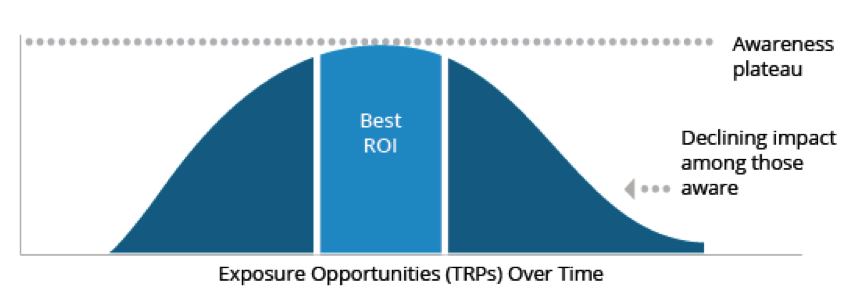You’ve done it – you’ve created the world’s best commercial! It’s captivating, solidly linked to the brand, communicates a strong message, and convinces people to go out and buy your product.
So now you can go retire, right? Unfortunately, even the best commercials have a lifecycle that we, as marketers and researchers, need to carefully monitor. Knowing when a commercial is delivering strong returns, when it has plateaued, and when it has worn out is key to maintaining a strong campaign in-market.
The debate over allocating “working” dollars to media versus “non-working” dollars to developing creative is long-standing. While we don’t advocate over-distributing non-working dollars, we caution that advertising campaigns require freshness in order to continue to engage and persuade. A single message repeated many times is not as powerful as multiple versions of a message that are refreshed and reinvigorated over time.
Surprisingly, a single commercial might reach wear-out sooner than you think. When that happens, your “working” dollars aren’t really working anymore – and could even be damaging your brand.
The first target rating points (TRPs) invested behind a commercial are going to work the hardest. At the beginning of the building cycle, each TRP you spend should bring in a large number of new audience members. However, after a certain point, those who have had exposure opportunities have chosen whether or not they are going to pay attention to an ad and (unless you drastically change your targeting/media plan) incremental TRPs won’t add additional audience members. This is called commercial plateauing.
You may think this is the time to stop running the commercial, but that is not the best strategy. In reality, commercials deliver their best ROI after they have plateaued. The audience has been maximized, and with added frequency the commercial can continue to be persuasive.
It’s the milestone that comes next that’s the catch. After a certain number of TRPs, the commercial is going to begin to wear out in its ability to persuade. Each additional exposure to the commercial is no longer convincing those who are seeing it yet again. Yes, commercials do wear out, stop working, sometimes even negatively affect the brand, and it is at this point that they should be replaced.
The level of TRPs it takes to reach this designation is different for every category, and depends on the strength of the creative. Using in-market advertising research is crucial for tracking when commercials reach each of these milestones and implementing a plan to refresh or replace a commercial as needed – so that your “working” dollars are still working.



